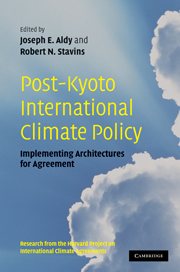Book contents
- Frontmatter
- Contents
- Harvard Environmental Economics Program, International Advisory Board
- Harvard Project on International Climate Agreements, Faculty Steering Committee
- Harvard Project on International Climate Agreements, Project Management
- List of figures
- List of tables
- List of contributors
- Foreword
- 1 Introduction
- Part I Alternative international policy architectures
- Part II Negotiation, assessment, and compliance
- Part III The role and means of technology transfer
- Part IV Global climate policy and international trade
- Part V Economic development, adaptation, and deforestation
- Part VI Modeling impacts of alternative allocations of responsibility
- Part VII Synthesis and conclusion
- 28 Epilogue
- 29 Lessons for the international policy community
- Appendix A Selected List of Individuals Consulted, Harvard Project on International Climate Agreements
- Appendix B Workshops and Conferences, Harvard Project on International Climate Agreements
- Glossary and Abbreviations
- Index
29 - Lessons for the international policy community
Published online by Cambridge University Press: 05 June 2012
- Frontmatter
- Contents
- Harvard Environmental Economics Program, International Advisory Board
- Harvard Project on International Climate Agreements, Faculty Steering Committee
- Harvard Project on International Climate Agreements, Project Management
- List of figures
- List of tables
- List of contributors
- Foreword
- 1 Introduction
- Part I Alternative international policy architectures
- Part II Negotiation, assessment, and compliance
- Part III The role and means of technology transfer
- Part IV Global climate policy and international trade
- Part V Economic development, adaptation, and deforestation
- Part VI Modeling impacts of alternative allocations of responsibility
- Part VII Synthesis and conclusion
- 28 Epilogue
- 29 Lessons for the international policy community
- Appendix A Selected List of Individuals Consulted, Harvard Project on International Climate Agreements
- Appendix B Workshops and Conferences, Harvard Project on International Climate Agreements
- Glossary and Abbreviations
- Index
Summary
The nations of the world confront a tremendous challenge in designing and implementing an international policy response to the threat of global climate change that is scientifically sound, economically rational, and politically pragmatic. It is broadly acknowledged that the relatively wealthy, developed countries are responsible for a majority of the anthropogenic greenhouse gases (GHGs) that have already accumulated in the atmosphere, but developing countries will emit more GHGs over this century than the currently industrialized nations if no efforts are taken to alter their course of development. The architecture of a robust international climate change policy will need to take into account the many dimensions and consequences of this issue with respect to the environment, the economy, energy, and development.
The Kyoto Protocol—which builds directly on the foundation laid by the United Nations Framework Convention on Climate Change (UNFCCC)—represented a first step toward addressing this long-term, global problem. Now, the international policy community needs to identify the next step, both in terms of setting sensible climate-related goals and in designing effective policies to achieve those goals. The Harvard Project on International Climate Agreements aims to aid and inform that process through a diverse set of research initiatives in Europe, the United States, China, India, Japan, and Australia. This book is a product of that research.
Drawing upon lessons from experience with the Kyoto Protocol (Aldy and Stavins, Chapter 1; and Schmalensee) and insights from economics, political science, international relations, legal scholarship, and other disciplines, the contributors to this volume have set forth a range of ideas about how best to construct a post-2012 international climate change policy regime.
- Type
- Chapter
- Information
- Post-Kyoto International Climate PolicyImplementing Architectures for Agreement, pp. 899 - 929Publisher: Cambridge University PressPrint publication year: 2009



